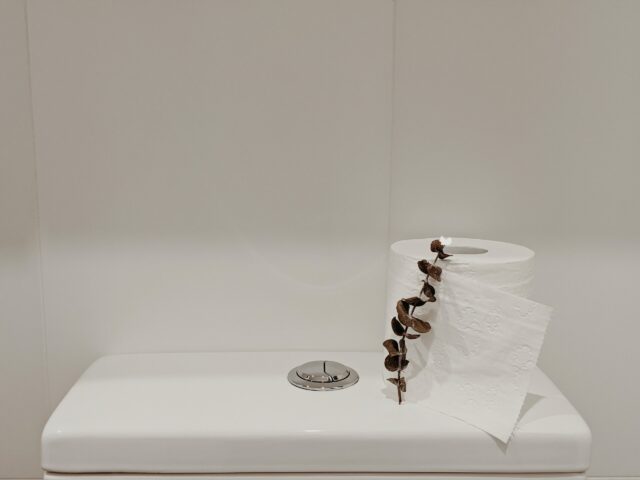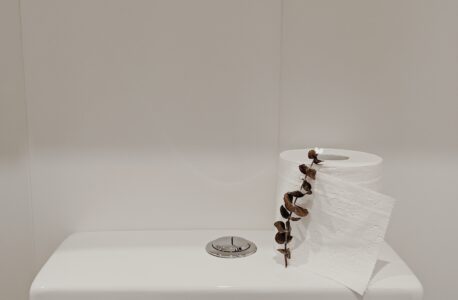‘Toilet cleaning.’ Well, nobody likes the sound of that, not to even mention the best way to clean a toilet tank. Yet, cleaning the toilet regularly is crucial, if you are to keep your bathroom clean and relaxing. However, when it comes to the actual toilet cleaning, most of us usually focus on the toilet bowl, overlooking one very important part; the toilet tank.

Why is it so Important to Clean a Toilet Tank?
The toilet tank functions to hold the water that is used to flush the toilet. Being a moist place, it is prone to develop mold, algae and rust. More so, the lid of the toilet tank easily builds up dirt, minerals and bacteria. If not removed, all the algae, dirt and mold that accumulate in the toilet tank can lead to rusting and corrosion of the metal parts. In turn, this could cause bowl staining or even permanent damage of the tank!
Therefore, it is important that you include cleaning the inside of your tank as part of your cleaning schedule. In fact, it is recommended that you clean the tank at least twice a year. By so doing, you will not only extend the life of your toilet tank, but also encourage a clean, fresh-smelling bathroom.
We Are Here to Help You!
This article discusses the most effective way on how to clean the inside of a toilet tank, as well as how to maintain its cleanliness after the cleaning process. Read on!
Best Way to Clean a Toilet Tank
Materials Needed:
- Rubber Gloves
- Sponge
- White Vinegar
- Scrub Brush (preferably one with a long handle)
- Disinfectant Cleaner
- Spray Bottle
The Process:
1. First, empty the toilet tank. You can do this by shutting off the water valve (the water valve resembles a tap and is usually located near the tank base or on the wall behind the toilet). After shutting off the valve, lift the tank lid so that you can see the water level inside the tank. Flush the toilet and allow it to drain off completely. Sometimes, you might even need to flush it twice or three times, depending on the flow rate.
2. Assess and determine the condition of your toilet tank. If the toilet tank only has surface grime and dirt, then only a bit of scrubbing and cleaning will be enough (proceed to step 4). However, if the walls or the bottom of the tank have some discoloration, then the toilet tank might require a more forceful cleaning method, such as vinegar. Discoloration in the tank usually indicates that residues, tough grime and mineral deposits have built up in the tank (proceed to step 3).
3. Fill the toilet tank with vinegar, so that the vinegar reaches the overflow value. Depending on your toilet tank size, you might require up to three gallons of vinegar. However, considering that vinegar is usually sold at a cheap price, you don’t have to worry about spending too much on the vinegar. Allow the vinegar to sit there in the toilet tank for at least 12 hours. Do not flush the toilet during this time. After the 12 hours have passed, flush the toilet to remove the vinegar. Again, you might be required to flush two to three times to remove all the white vinegar.
4. In a spray bottle, add your preferred disinfectant cleaner. Then, spray the interior of the tank generously, especially on the bottom and along the walls of the tank. Try your best not to spray any metal parts of the tank; the disinfectant cleaner might have corrosive additives which could react and corrode the metal (a good example of such corrosive disinfectants is bleach). Let the disinfectant cleaner sit for about ten to fifteen minutes.
5. Using a scrub brush and with your rubber gloves on, thoroughly scrub the toilet tank. Scrub the bottom of the tank, the corners, along the walls and around the fixtures. Remove any build-up and grime, applying more cleaner where necessary. It is always recommended that you use a new scrub brush each time you clean your toilet tank; an old brush can transfer contaminants from the previous cleaning to your tank. Also, long, narrow scrub brushes that have medium-firm bristles are much more effective when it comes to scouring the tank bottom and corners.
6. Clean the working parts of the toilet tank using the disinfectant cleaner. However, since directly spraying the disinfectants could lead to corroding of the working parts, you should dilute it first. Soak a clean sponge in warm water, then spray a little disinfectant on the sponge. Using the wet sponge, wipe down the different parts of the tank, such as the flapper and ball float. Rinse the sponge and re-soak it, repeating the process until each working part is sparkling clean.
7. Turn on the water valve and allow the toilet tank to fill completely. Flush it several times to see how clean the tank is. If the tank still doesn’t appear clean enough to you, drain it, then repeat steps 4 to 6 again. Once you are satisfied with how clean your toilet tank is, turn the water valve back on, return the lid and you can continue using the toilet ad normal.
Easy Heavy Duty Cleaning:
If you’re looking for an easy heavy-duty toilet tank cleaning, Instant Power 1806 Toilet Tank Cleaner is all you need. Being a highly concentrated cleaner, it helps you get rid of tough stains very easily. Simply pour 8 oz of the cleaner into your toilet bowl, stir the water to ensure a consistent mixture and let it sit overnight before flushing.
How to Keep a Toilet Tank Clean
It is one thing to clean the inside of a toilet tank, and it is yet another to keep it clean. The following are tips on how you can keep your toilet tank clean day in and day out:
- Regularly put tank tablets in the tank – These tablets help to reduce bacteria contamination, minerals and mildew in the tank. However, avoid buying commercial tank tablets that consist of bleach; rather, go for those that are mentioned as being ‘natural’ or ‘chemical-free.’
- Regularly drain the toilet tank, then fill it with vinegar – You can also leave the vinegar solution overnight, only flushing the toilet in the morning. Vinegar helps to prevent any build-up of mineral deposits and mildew in the toilet tank.
Everyone can agree that cleaning the inside of a toilet tank is not fun. Yet, it is worth every effort and time spent. A clean toilet tank means a clean bathroom and a fresh-smelling space. What’s even better, cleaning the toilet tank requires very little effort from you. After all, the vinegar does all the work for you.
Therefore, unless you want to spend a lot of money replacing corroded toilet tank parts, follow the above recommended method on the best way to clean a toilet tank.







